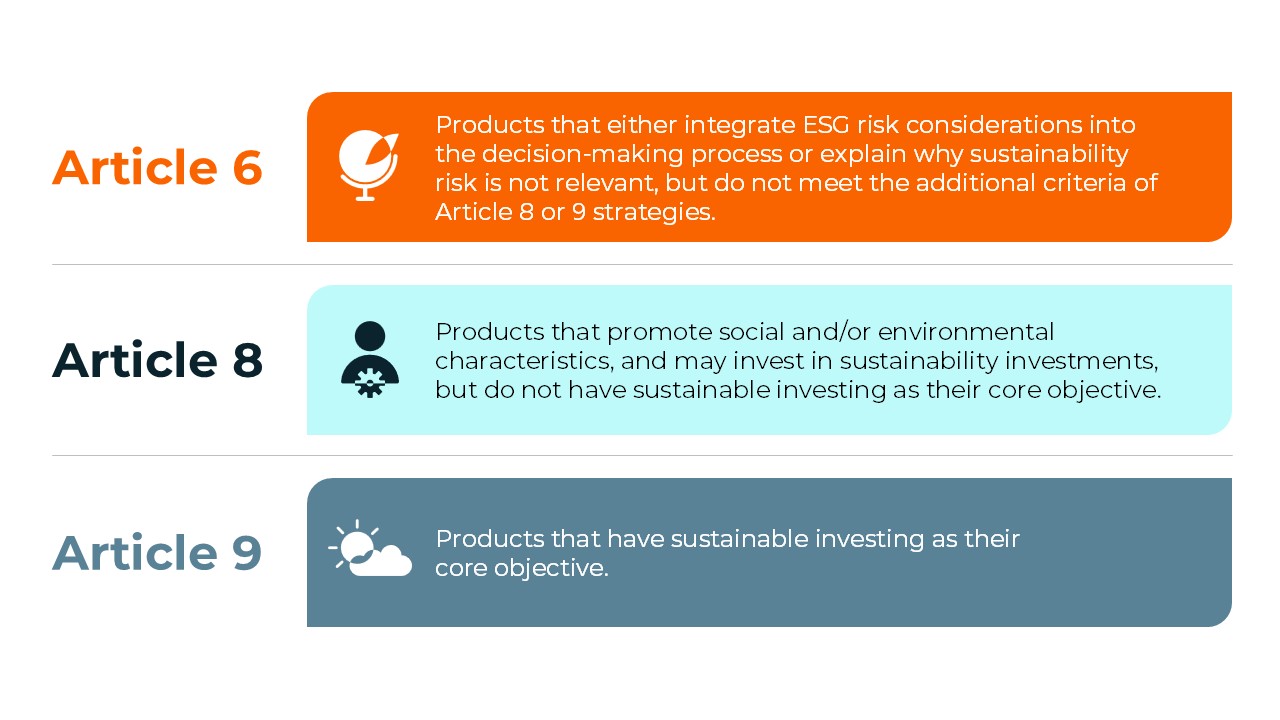
Subscribe to stay informed, inspired and involved.
The European Union’s (EU) Sustainable Finance Disclosure Regulation (SFDR) is at a pivotal crossroads. In May 2025, the European Commission launched a sweeping Call for Evidence to overhaul the framework’s architecture, signaling potential replacement of the familiar Article 6, 8, and 9 fund categories with a more intuitive labeling system. Simultaneously, the European Supervisory Authorities (ESAs) released new technical updates to the existing rules, introducing standardized emissions targets, enhanced Principal Adverse Impact (PAI) disclosures, and machine-readable templates.
These developments underscore a fundamental shift from a transparency-first framework to one seeking greater clarity, usability, and regulatory coherence. As the EU rethinks its sustainability rulebook, fund managers must navigate short-term disclosure demands and longer-term strategic shifts. Below, we outline the SFDR requirements today and what firms should do now to stay ahead for longer-term reporting.
History of SFDR
In 2018, SFDR became part of the EU’s broader Sustainable Finance agenda, which intended to reorient capital flows toward sustainable investments supporting the EU’s climate goals. SFDR aimed to enhance transparency in the financial sector by requiring financial market participants (FMPs) and financial advisers (FAs) to disclose how they integrate sustainability risks and consider adverse sustainability impacts in their investment decisions – ideally making it easier for institutional investors to compare and evaluate the sustainability characteristics of different financial products or funds.
Overview of Current Requirements
SFDR requires FMPs and FAs to disclose product- or fund-level information and entity-level disclosures based on the fund’s classification (Article 6, 8, or 9). Companies must disclose this on their organization’s website, in pre-contractual documentation, or periodic investor reporting.
Funds that either promote environmental or social characteristics (if Article 8) or have a sustainable investment objective (if Article 9) have more extensive reporting requirements. Article 6 funds, which do not focus on sustainability, have fewer disclosure obligations.

Entity-Level Disclosures1: FMPs and FAs must disclose on their websites whether and how they consider PAIs on sustainability factors for their investment decisions and describe the integration of sustainability risks across due diligence and remuneration policies. Pre-contractual documentation should outline how sustainability risks are factored into investment decisions and their potential impact on financial product returns.
Product-Level Disclosures: In pre-contractual documentation, FMPs and FAs must disclose environmental or social characteristics (if Article 8), sustainable investment objectives (if Article 9), sustainability risks, and PAIs by SFDR-prescribed templates Annex II (if Article 8) or Annex III (if Article 9).2 Articles 8 and 9 funds must also provide annual updates to investors with quantitative data to validate efforts described in precontractual documentation. These periodic disclosures must be made using SFDR-prescribed templates Annex IV (if Article 8) or Annex V (if Article 9).3
Industry feedback on SFDR has highlighted issues with clarity and consistency. Vague definitions of key concepts have led to varied interpretations and inconsistent disclosures from FMPs and FAs, who risk over- or under-reporting and contributing to greenwashing. Complex reporting requirements are viewed as neutral without real mechanisms for promoting sustainable investment. These critiques, among others, prompted the European Commission’s May 2025 Call for Evidence.
What the Call for Evidence Proposes
The European Commission’s Call for Evidence,4 launched on May 2nd and closed on May 30th, clearly signals that SFDR’s foundational structure could be up for reform. The potential rewrite of the SFDR requirements would move from a transparency regime to a classification and labeling system that’s clearer, more consistent, and aligned with the EU’s broader sustainable finance framework.5 Three key changes:
Shift from Articles to Labels
While the well-known Article 6/8/9 classification was never intended to be a labeling regime, it has evolved into such, leading to interpretation gaps, inconsistent application across funds, and compliance risks. In response, the Commission is considering replacing these Articles with new product categories, which would reflect the various sustainability objectives of each product, such as products contributing to a sustainability objective, products contributing to the transition, or products contributing to ESG strategies.6
Clarification of Key Concepts
Certain key concepts of the SFDR regime, such as “sustainable investment” and “do no significant harm (DNSH)”, have faced criticism for their lack of alignment with other EU sustainability frameworks, such as the EU Taxonomy and CSRD. The Commission is considering revising these concepts to promote better alignment across regulations and support funds operating in transition-heavy sectors such as energy and infrastructure, often penalized under current SFDR guidance.2
Increasing Usability for Retail Investors
The current disclosure formats of Annex II through V have been criticized as being inaccessible and dense, and the Commission is exploring simpler formats, like a standardized ESG dashboard, to make information more straightforward, as well as more actionable and comparable to a retail investor audience.7
When the Commission closed the Call for Evidence on May 30th, it received nearly 200 responses from various stakeholders. Most submissions supported the Commission’s potential labeling changes, with many supporting an additional impact fund category. While some reactions called for simplifications of the regulation, such as regulatory carve-outs for alternative investment funds marketed exclusively to professional investors, others called for an expanded scope, such as BNP Paribas writing for an extension of SFDR’s scope to cover structured products, which are currently excluded.8
What’s Changing Now: The ESA’s Technical Update (RTS Revision)
While the Commission looks ahead to larger structural reforms, the ESAs have already made key technical updates to the SFDR. These changes, which were published in December 20239 apply to 2025 disclosures and aim to improve data quality, comparability, and usability. Key updates included:
Expanded and Refined Principal Adverse Impact (PAI) Indicators
The revised RTS introduced new mandatory social PAI indicators aligned with the ESRS standards, covering adequate wages, tax havens, tobacco exposure, and grievance mechanisms. Already established environmental PAIs were refined to include clearer calculation methods and optional indicators for nuanced metrics.
Greenhouse Gas (GHG) Emissions Reduction Targets
Firms must disclose GHG emissions reduction targets, including interim milestones, in pre-contractual documents, websites, and periodic reports. Investments without targets aren’t penalized, but full disclosure obligations apply only to target-aware products. Targets must align with a five-year review cycle and reference the Paris Agreement’s 1.5 °C goal.
Streamlined Reporting Via Pre-Contractual and Periodic Templates
Reporting disclosure templates have been simplified to include a dashboard summarizing key metrics (sustainable investments, GHG targets, Taxonomy alignment) and mandatory machine-readable formats to facilitate automated data consumption.
Enhanced, But Not Overhauled, Do No Significant Harm (DNSH) Disclosures
As a result of the Commission's consultations on SFDR, the ESAs decided not to suggest long-term revisions to the DNSH concept. Instead, they now require firms to disclose the threshold criteria used to apply DNSH to their funds, adding transparency around testing methodology for the idea. They also clarified that any Taxonomy-aligned activities will already be considered sustainable investments.
What This Means for Funds
As the European Commission explores a structural overhaul of SFDR, the ESAs have already activated parallel upgrades through their RTS amendments, which will be applied in 2025. These updates are not isolated; they lay the groundwork for the sweeping principles discussed by the Commission.
For fund managers, SFDR is no longer a static compliance exercise. With the ESA’s updated disclosure rules taking effect in 2025 and a possible regulatory overhaul via the Commission, firms must now operate on two tracks: deliver under current rules and prepare for a new, potentially label-driven regime.
The ESA updates are enforceable and imminent. This year, firms must:
- Report enhanced PAI indicators, including new social metrics
- Disclose GHG emissions targets if they exist
- Adopt the dashboard style templates, including machine-readable formatting
- Be transparent about how DNSH thresholds are applied
While formal proposals from the Commission are due by Q4 2025, making the exact outcomes uncertain, it is fair to assume that changes to the SFDR regime are coming. Preparing now means:
- Reviewing product positioning: If Article 8/9 labels disappear, how would your fund fit into potential new categories like “transition,” “impact,” or “sustainable”?
- Building adaptable data systems: Flexible ESG data pipelines will be critical as definitions and reporting expectations evolve
- Monitoring EU alignment: Expect increasing convergence between SFDR, CSRD, the EU Taxonomy, and investor disclosure expectations
Firms that treat SFDR as a one-time compliance burden may soon find themselves behind. The best-positioned asset managers will approach today’s updates as an opportunity to future-proof their products, strengthen investor trust, and shape the sustainable finance rulebook before it’s rewritten.
[4] https://ec.europa.eu/info/law/better-regulation/have-your-say/initiatives/14666-Revision-of-EU-rules-on-sustainable-finance-disclosure_en
[5] https://www.regulatoryandcompliance.com/2025/05/final-opportunity-to-shape-sfdrs-future-in-european-commissions-call-for-evidence/
[6] https://www.ropesgray.com/en/insights/viewpoints/102kb8o/final-call-for-evidence-on-the-shape-of-sfdr
[7] https://www.simmons-simmons.com/en/publications/cmaf8y58500loug94khk4f45s/esg-commission-calls-for-views-on-revising-the-sfdr?
[8] https://www.ipe.com/news/investors-fight-over-what-should-be-included-in-future-sfdr-regime/10130850.article?
[9] https://www.esma.europa.eu/sites/default/files/2023-12/JC_2023_55_-_Final_Report_SFDR_Delegated_Regulation_amending_RTS.pdf
Summary
The European Union’s (EU) Sustainable Finance Disclosure Regulation (SFDR) is at a pivotal crossroads. In May 2025, the European Commission launched a sweeping Call for Evidence to overhaul the framework’s architecture, signaling potential replacement of the familiar Article 6, 8, and 9 fund categories with a more intuitive labeling system. Simultaneously, the European Supervisory Authorities (ESAs) released new technical updates to the existing rules, introducing standardized emissions targets, enhanced Principal Adverse Impact (PAI) disclosures, and machine-readable templates.
Author

Julia Sullivan
Director, Sustainability
julia.sullivan@sodali.com

Carson Smith
Senior Associate, Sustainability
carson.smith@sodali.com